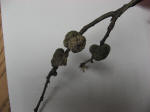|
Garlic mustard and galls
By John
Fulton
 Send a link to a friend
Send a link to a friend
[April
21, 2010]
A new weed problem has reared its ugly head in
the Logan County area. Garlic mustard is making its presence known
in many wooded, or formerly wooded, areas. No, garlic mustard is not
exactly new, but it is expanding its range at a very speedy rate.
|
 Garlic mustard is considered an invasive species, and some
states have declared it a noxious weed. Illinois hasnít declared
it such, at least not yet. The problem with garlic mustard is
how quickly it spreads. It spreads so quickly it tends to choke
out much of the desirable undergrowth in timber areas. Garlic mustard is considered an invasive species, and some
states have declared it a noxious weed. Illinois hasnít declared
it such, at least not yet. The problem with garlic mustard is
how quickly it spreads. It spreads so quickly it tends to choke
out much of the desirable undergrowth in timber areas.Garlic
mustard is a cool-season biennial herb with stalked, triangular
to heart-shaped, coarsely toothed leaves that give off an odor
of garlic when crushed. First-year plants appear as a rosette of
green leaves close to the ground. Rosettes remain green through
the winter and develop into mature flowering plants the
following spring. Flowering plants of garlic mustard reach from
2 to 3 1/2 feet in height and produce buttonlike clusters of
small white flowers, each with four petals in the shape of a
cross.

 Control of garlic mustard is somewhat difficult. Seeds can
remain viable for at least five years in the soil. Small amounts
can be pulled up, including the roots. Garlic mustard can regrow
from root material. For herbicides, glyphosate (Roundup) is the
most often recommended. Remember, glyphosate kills broadleaves
and grasses it gets on. There has been some success with 2,4-D
LV400 where there arenít concerns with other understory plants.
Very large patches have been controlled with fire, but that
completely destroys the understory of timbers. Remember to
monitor areas for at least five years due to the seed dormancy
period. Control of garlic mustard is somewhat difficult. Seeds can
remain viable for at least five years in the soil. Small amounts
can be pulled up, including the roots. Garlic mustard can regrow
from root material. For herbicides, glyphosate (Roundup) is the
most often recommended. Remember, glyphosate kills broadleaves
and grasses it gets on. There has been some success with 2,4-D
LV400 where there arenít concerns with other understory plants.
Very large patches have been controlled with fire, but that
completely destroys the understory of timbers. Remember to
monitor areas for at least five years due to the seed dormancy
period.
[to top of second column]

 |
 Galls
 A group of problems showing up is related to galls. Galls are
swelling of leaves, twigs or other plant parts. Most are caused by
mites or wasps. They damage the plant parts, and the plant responds
with a gall. In the case of leaves, the swelling is actually leaf
tissue. There is no way to get rid of it without tearing a small
hole in the leaf. A group of problems showing up is related to galls. Galls are
swelling of leaves, twigs or other plant parts. Most are caused by
mites or wasps. They damage the plant parts, and the plant responds
with a gall. In the case of leaves, the swelling is actually leaf
tissue. There is no way to get rid of it without tearing a small
hole in the leaf.
This is something I like to refer to as similar to you getting a
mosquito bite. The damage comes in and a swelling occurs.
The maple leaf bladder gall will be easily spotted on silver
maples in the area shortly, and oak leaves in the red oak group are
also showing galls. Oak trees probably have more galls than any
other group of trees. Several samples have also been brought in of
the stem types of galls. Fortunately, the oak galls are usually not
the type to kill tissue beyond them. However, the galls arenít the
most pleasant things to look at. That is the main thing -- they are
unsightly.
There is no cure for galls, as they are caused by insects before
you see the swellings. The timing makes it impossible to try to
prevent the insects.
To-do list
-
Prune flowering
shrubs after they finish flowering.
-
We are on the
early end of the time period (April 25 to May 10) for planting
tender vegetables such as snap beans, sweet corn, New Zealand
spinach and tomato plants
-
May 10 begins the time for planting
warm-loving vegetables such as squash, melons, cucumbers and
sweet potato slips. This is also a "more assured" date for
planting annual flowers.
[By
JOHN FULTON,
University of Illinois Extension, Logan County]
 |